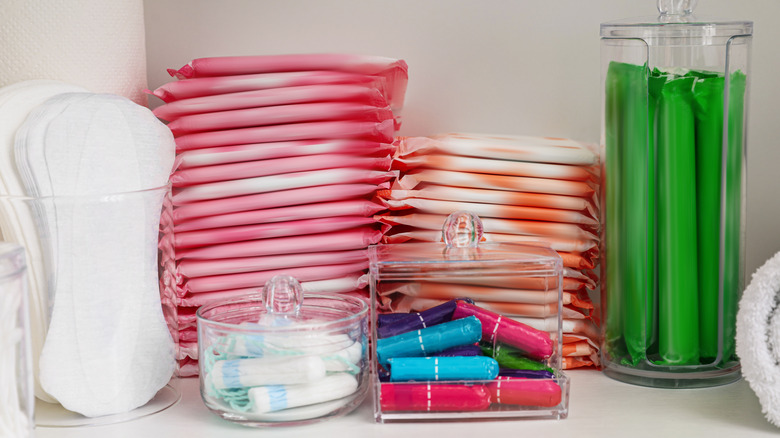What It Means When You Have Yellow-Green Vaginal Discharge
Suddenly noticing a change in the color, consistency, or appearance of vaginal discharge may lead to instant panic, but being informed about the meanings and causes of vaginal variations can let you know what's going on before your mind jumps to its own conclusions. Vaginal discharge can change colors, with possible shades including red, white, clear, pink, gray, mauve, yellow, and green (via Healthline). Many times, changes in vaginal discharge color are normal fluctuations in the menstrual cycle and are caused by hormonal adaptations during experiences, like pregnancy. Sometimes, though, the color of your vaginal discharge may be your body sending you a sign that something isn't quite right and you should seek medical attention. Knowing what each color of vaginal discharge represents is the first step in deciphering the meaning of your own discharge.
Vaginal discharge is a normal thing to experience and the color, texture, and amount can frequently vary, per Mayo Clinic. It is indicative of the female reproductive cycle and often changes in appearance throughout the menstrual cycle phases. Comprised of fluid and cells that the uterus, cervix, and vagina shed every month, vaginal discharge serves to protect the vaginal tissue from harmful bacteria, infections, and irritation from dryness. A healthy discharge tends to fluctuate in consistency by appearing watery, thin, sticky, and thick. If vaginal discharge suddenly begins to produce a foul odor, concerning color, or side effects, like itching and irritation, your body could be signaling that something is awry.
Yellow-green discharge can be good or bad
Along the shades of the rainbow that make up the hues of vaginal discharge, it might be alarming to suddenly notice yellow or green discharge. According to MedicalNewsToday, having a light yellow discharge is typically not a reason to be worried. Vaginal discharge with a yellow shade can often be attributed to dietary changes, especially if the sudden transition to a yellow hue occurs after altering your diet or taking dietary supplements. Keeping a log of the appearance of your discharge can help you track changes in appearance and connect any new variations to dietary changes or other lifestyle modifications. If you haven't made any recent adjustments to your diet or activity and yellow vaginal discharge is accompanied by a smelly odor, then there may be underlying issues like sexually transmitted infections (STIs) or bacterial infections that require medical attention.
Dark yellow or green discharge is frequently a signal of an abnormal change in vaginal health (via Flo). While light yellow discharge is often normal when accompanied by a lifestyle change, bright yellow, yellow-green, and any shade of green vaginal discharge is usually symbolic of bacterial growth, infections, and other urgent medical concerns. Green vaginal discharge often represents bacterial infections, and the color arises when pathogen-induced inflammation occurs in the vagina. If yellow discharge transitions into yellow-green and then mucus-like green discharge, you should seek attention from your healthcare provider to determine the cause of possible infection and learn how to treat it.
Infections that alter vaginal discharge color
There are several types of infections and pathogens that can affect the appearance of vaginal discharge and cause color variations, particularly changes to yellow-green hues. The Cleveland Clinic reports that vaginal discharge with foul odors, texture changes similar to mucus or thick clumps, and new color appearances can indicate one of many possible underlying conditions that require medical attention. If your vaginal area is itchy, sore, or painful, in addition to changes in discharge color, then a yeast infection may be the culprit. When a fungus called candida grows in extreme quantity within the vaginal realm, an overproduction of yeast can lead to thick discharge resembling cottage cheese and be accompanied by excessive itchiness that can cause swelling and pain in your intimate area. To resolve a yeast infection, the most common treatment is anti-fungal medications.
For women who are sexually active, many causes of vaginal infections stem from sexually transmitted infections (STIs). Trichomoniasis, or trich for short, gonorrhea, and chlamydia are STDs that frequently result in changes to vaginal discharge, including color alterations presenting in shades of yellow-green. When the vaginal discharge is a hue of yellow or green and has a foamy appearance, trichomoniasis is a potential reason for the noticeable changes. Caused by a parasite and treated with antibiotics, trichomoniasis can also present with gray coloration or a texture similar to a bubbly appearance. Trichomoniasis usually produces an identifiable itch as well (via Mayo Clinic).
Treating and preventing yellow-green discharge
It's critical to determine the cause of any yellow-green vaginal discharge and treat underlying conditions. For instance, infections, like gonorrhea and chlamydia, can spread outside of the vaginal area and lead to pelvic inflammatory disease if not treated in a timely manner, according to Cleveland Clinic. Both chlamydia and gonorrhea frequently involve changes in vaginal discharge color to yellow-green with a cloudy appearance, so if you notice such changes then schedule an appointment with your doctor for a course of antibiotic treatment. When it comes to treating yellow-green vaginal discharge, seeking confirmation of the underlying cause from a trained medical professional can help you quickly receive the treatment you need, whether it's anti-fungal medication for yeast infections or antibiotics for several sexually-transmitted infections (STIs).
To avoid unwanted yellow-green discharge, practicing healthy vaginal hygiene can help keep unwanted infections at bay. This consists of staying away from scented and perfumed products, from body washes to soaps to sanitary wipes. Instead, only washing your vaginal area with warm water and mild soap is one of the best ways to prevent infections and fungal buildup. Using unscented feminine hygiene products is also recommended, as is not using scented tampons or pads during your period, as advised by GoodRx Health. Even scented laundry detergent can lead to unwanted changes in vaginal discharge, so it's best to stick with unscented products when washing clothes. Other tips include wearing loose-fitting cotton undergarments, removing tampons within eight hours, and eliminating douching.




